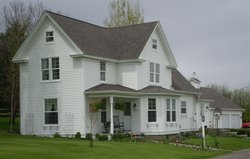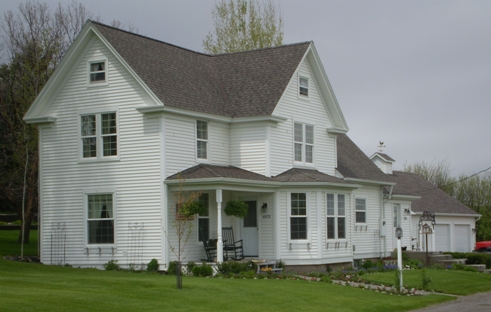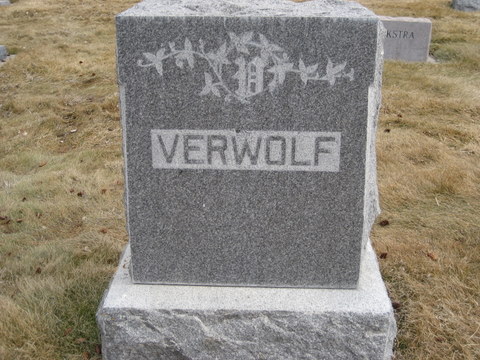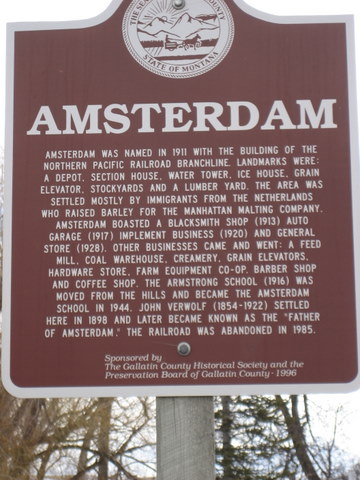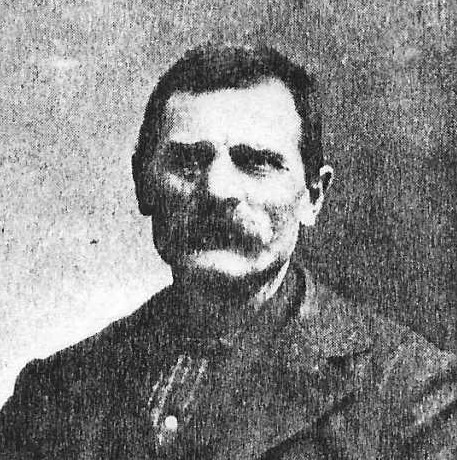Johannes was very probably baptized in the Nederlands Hervormde kerk (Dutch Reformed Church, DRC), either in the large one in Ameide, or in the quaint little one in the tiny village Tienhoven, near their home.
Johannes worked on a river boat selling and delivering coal and cabbages. At the age of sixteen he enlisted in the Dutch Merchant Marine and sailed to the Dutch East Indies and around the world via both southern capes. With lot number 6 Johannes Verwolf was drawn to fulfill the national army duty, which lasted in those days five years, and was enrolled on 13 May 1874. On 18 December 1875 he got from the Minister of Marine permission to marry. [Source: scan of marriage appendix, Familysearch, 10/2012.] Home again at 21, labourer Johannes married on 22 January 1876 in their birthtown Ameide to Dirkje van Es and made since May 1876 their home in Ameide, Achterweg 144 (= Backroad, nowadays called Van Puttestraat), at the foot of the Lek dike, where their three oldest children were born: Joris (in the USA: George), born 19 June 1876, Gijsbert (Guy), born 12 October 1877, and Leendert (Leonard), born 19 November 1879. As usual the two oldest sons were named for their grandfathers, the third, Leendert, for an uncle.
After 1881 they moved to Franschestraat 210 and then back to Achterweg, nr. 129. On 30 March 1886 Dirkje moved with her three children to Tienhoven, another riverdike village at the Lek very nearby, after her husband Johannes Verwolf, still a labourer, had left alone for America. It is told in the family that Dirkje's father Gijsbert van Es had forbidden her to go to America. He died in April 1887 in Tienhoven. On 28 October 1887 Dirkje and her three children returned to Ameide, Franschestraat 213 and, later on, Donkerstraat 172. [Submitted by P. Hakze, 11/2011, based on scans of several official local government documents.]
In Ameide John contracted with the government to raise the level of the dike on the river Lek. After completing this job, he went back to sea and jumped ship in "Amerika" around 1881, settling in the Dutch Reformed community of Pella, Iowa where he worked in the coal mines and bought a house for his wife and family to join him. When they did not, he sold the house and headed west, first to Lusk, Wyoming, on to Lead, SD where he worked in the mines, and then on to the Dutch agrarian settlement Harrison, Douglas County, in southeast South Dakota, where he bought a farm which he worked for the next seven years.
At age 35, John returned to Holland after an eight year absence and brought in February 1890 his wife Deerkje and their three children, George, Guy, and Len back to Douglas County, SD where the next four children were born: Maggie, born 13 December 1891, Ira, born 24 November 1892, Dick, born 12 January 1894, and Lena, born 2 October 1895.
Around 1897, the family left South Dakota, with John and sons Guy and Len traveling via team and wagon, while the oldest son George, mother Deerkje, and four younger siblings followed via a railway boxcar. They settled in the Gallatin Valley in southwestern Montana, just northwest of Yellowstone National Park in Wyoming, on an irrigated farm, on Camp Creek, eight miles south of Manhattan, in a new Dutch community of 10 to 12 families. The farm was a quarter section (160 acre, almost 65 hectare) with a fairly good-sized log cabin on it and a log barn, nothing else. It had no well, no fences, no granary, no chicken coop and no garden. Manhattan and Belgrade, both eight horse miles away, were the only places to buy groceries or any of the necessities for farming and living.
Four years after the family's arrival in Montana, shortly after the birth of their youngest son John (born 6 October 1899) Deerkje became ill with tuberculosis and died on 16 November 1902.
John remarried on 2 March 1905 to the 23 years younger Helen VanderSchaaf Schuurmans, since about February 1901 widow of Pieter Schuurmans of New Jersey, with two children, Mike (Meinte), age 4, and Anna, age 3. Some time before she had moved with her children as housekeeper in at the home of John's bachelor sons George and Guy Verwolf. Five more children were born of this marriage: William, born 22 July 1906, twins Jacob and Peter, born 20 June 1909, Julia, born 5 June 1913, and a baby who lived just one week.
In 1909 a brand new, big and for those days quite luxurious house was built. This house still stands nowadays as a landmark of Amsterdam, Montana.
John Verwolf is known as "The Father of Amsterdam, Montana", the name that was suggested for the settlement by his wife, Helen, when Northern Pacific Railway built a freight line spur from Manhattan to Anceny in 1911. John was one of the early Dutch settlers, very active in the community, well-respected for his contributions to the progress of this early settlement, and admired for his genuineness, his generosity and irrepressible humor.
Submitted by Joanne Verwolf from the writings of John's son, William (Bill) Verwolf
Johannes was very probably baptized in the Nederlands Hervormde kerk (Dutch Reformed Church, DRC), either in the large one in Ameide, or in the quaint little one in the tiny village Tienhoven, near their home.
Johannes worked on a river boat selling and delivering coal and cabbages. At the age of sixteen he enlisted in the Dutch Merchant Marine and sailed to the Dutch East Indies and around the world via both southern capes. With lot number 6 Johannes Verwolf was drawn to fulfill the national army duty, which lasted in those days five years, and was enrolled on 13 May 1874. On 18 December 1875 he got from the Minister of Marine permission to marry. [Source: scan of marriage appendix, Familysearch, 10/2012.] Home again at 21, labourer Johannes married on 22 January 1876 in their birthtown Ameide to Dirkje van Es and made since May 1876 their home in Ameide, Achterweg 144 (= Backroad, nowadays called Van Puttestraat), at the foot of the Lek dike, where their three oldest children were born: Joris (in the USA: George), born 19 June 1876, Gijsbert (Guy), born 12 October 1877, and Leendert (Leonard), born 19 November 1879. As usual the two oldest sons were named for their grandfathers, the third, Leendert, for an uncle.
After 1881 they moved to Franschestraat 210 and then back to Achterweg, nr. 129. On 30 March 1886 Dirkje moved with her three children to Tienhoven, another riverdike village at the Lek very nearby, after her husband Johannes Verwolf, still a labourer, had left alone for America. It is told in the family that Dirkje's father Gijsbert van Es had forbidden her to go to America. He died in April 1887 in Tienhoven. On 28 October 1887 Dirkje and her three children returned to Ameide, Franschestraat 213 and, later on, Donkerstraat 172. [Submitted by P. Hakze, 11/2011, based on scans of several official local government documents.]
In Ameide John contracted with the government to raise the level of the dike on the river Lek. After completing this job, he went back to sea and jumped ship in "Amerika" around 1881, settling in the Dutch Reformed community of Pella, Iowa where he worked in the coal mines and bought a house for his wife and family to join him. When they did not, he sold the house and headed west, first to Lusk, Wyoming, on to Lead, SD where he worked in the mines, and then on to the Dutch agrarian settlement Harrison, Douglas County, in southeast South Dakota, where he bought a farm which he worked for the next seven years.
At age 35, John returned to Holland after an eight year absence and brought in February 1890 his wife Deerkje and their three children, George, Guy, and Len back to Douglas County, SD where the next four children were born: Maggie, born 13 December 1891, Ira, born 24 November 1892, Dick, born 12 January 1894, and Lena, born 2 October 1895.
Around 1897, the family left South Dakota, with John and sons Guy and Len traveling via team and wagon, while the oldest son George, mother Deerkje, and four younger siblings followed via a railway boxcar. They settled in the Gallatin Valley in southwestern Montana, just northwest of Yellowstone National Park in Wyoming, on an irrigated farm, on Camp Creek, eight miles south of Manhattan, in a new Dutch community of 10 to 12 families. The farm was a quarter section (160 acre, almost 65 hectare) with a fairly good-sized log cabin on it and a log barn, nothing else. It had no well, no fences, no granary, no chicken coop and no garden. Manhattan and Belgrade, both eight horse miles away, were the only places to buy groceries or any of the necessities for farming and living.
Four years after the family's arrival in Montana, shortly after the birth of their youngest son John (born 6 October 1899) Deerkje became ill with tuberculosis and died on 16 November 1902.
John remarried on 2 March 1905 to the 23 years younger Helen VanderSchaaf Schuurmans, since about February 1901 widow of Pieter Schuurmans of New Jersey, with two children, Mike (Meinte), age 4, and Anna, age 3. Some time before she had moved with her children as housekeeper in at the home of John's bachelor sons George and Guy Verwolf. Five more children were born of this marriage: William, born 22 July 1906, twins Jacob and Peter, born 20 June 1909, Julia, born 5 June 1913, and a baby who lived just one week.
In 1909 a brand new, big and for those days quite luxurious house was built. This house still stands nowadays as a landmark of Amsterdam, Montana.
John Verwolf is known as "The Father of Amsterdam, Montana", the name that was suggested for the settlement by his wife, Helen, when Northern Pacific Railway built a freight line spur from Manhattan to Anceny in 1911. John was one of the early Dutch settlers, very active in the community, well-respected for his contributions to the progress of this early settlement, and admired for his genuineness, his generosity and irrepressible humor.
Submitted by Joanne Verwolf from the writings of John's son, William (Bill) Verwolf
Family Members
-
![]()
George "Joris" Verwolf Sr
1876–1970
-
![]()
Guy "Gijsbert" Verwolf
1877–1945
-
![]()
Leonard "Leendert" Verwolf
1879–1947
-
![]()
Maggie Verwolf Kaspersma
1891–1979
-
![]()
Ira Cornelius Verwolf
1892–1964
-
![]()
Dick Verwolf
1894–1980
-
![]()
Lena Verwolf Latta
1895–1979
-
![]()
John Verwolf Jr
1899–1918
-
![]()
Rev William "Bill" Verwolf
1906–1996
-
![]()
Jacob Verwolf
1909–1910
-
![]()
Peter Verwolf
1909–1919
-
![]()
Julia Verwolf VanderArk
1913–2001
-
![]()
Infant Daughter Verwolf
1916–1916
Sponsored by Ancestry
Advertisement
Advertisement
